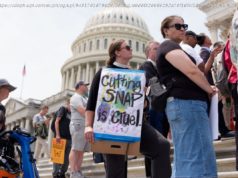President Donald Trump on Thursday signed an executive order that he says will „fix“ a health care system broken by Obamacare. „Today is only the beginning,“ Trump said during a news conference, the 49th in his nearly nine months as president.
SALT LAKE CITY — President Donald Trump on Thursday signed an executive order that he says will „fix“ a health care system broken by Obamacare.
„Today is only the beginning,“ Trump said during a White House news conference, the 49th in his nearly nine months as president of the United States.
But because any changes to laws, rules and regulations require study, public comment and implementation phases, it might be some time before Utah consumers actually realize any change.
„This is an uncomfortable situation for insurers to be in and an uncomfortable position for the consumers who rely on consistent coverage,“ said Jason Stevenson, director of education and communications with the Utah Health Policy Project, which advocates for Utah’s uninsured.
Stevenson said insurers are „very concerned“ with the news coming out of Washington, D. C., and people planning to enroll in the federal marketplace may also be confused by it all.
Open enrollment for individuals and families who do not have access to affordable health benefits through an employer begins via healthcare.gov on Nov. 1, extending to the end of the year — a period that has already been cut short by the Trump administration.
„It really fits into a pattern of sabotage of the individual market in Utah and across the country of trying to confuse people about what’s going on and what’s available, and (it’s) also making insurers very nervous about what’s in store,“ Stevenson said. „It makes it very hard for them to practice their business.“
And what’s proposed in Thursday’s order, “ Promoting Healthcare Choice and Competition Across the United States,“ isn’t exactly feasible, said Steve Gooch, public information officer with the Utah Insurance Department .
„Utah law at the moment doesn’t allow insurance to be sold like the president is proposing,“ Gooch said, „so changes would have to be done legislatively to make that happen. It would take some time to do.“
Sean Dunroe, director of product development, business development and strategy at SelectHealth, told members of the Utah Legislature’s Health Reform Task Force on Wednesday that the market is „extremely challenging“ as it is.
The higher premiums go, the „more likely we are to have people drop out of the market that just can’t afford health care coverage,“ Dunroe said.
„As lower-risk individuals drop out of an insurance pool, the costs continue to go up for everybody and it becomes difficult to sustain it over time,“ he said, adding that federal actions could cause instability in the market.
The executive order lengthens terms for short-term/catastrophic plans to up to a year, which means younger, healthier people might opt for the cheaper coverage, making costs higher for everyone else, Dunroe pointed out.
Some think the move may be more political than anything, pressuring Congress to arrive at a solution to „repeal and replace Obamacare,“ as the Trump administration has promised to do.
And Trump said he’s going to „pressure Congress very strongly to finish the repeal and the replace of Obamacare for all.“
Democrats denounced Trump’s order as more „sabotage,“ while Republicans called it „bold action“ to help consumers. A major small-business group praised the president, while doctors, insurers and state regulators said they have concerns and are waiting to details.
„We want to make sure that all the consumer protections are there and included,“ said Michael Munger, president of the American Academy of Family Physicians.
One of the main ideas from the administration involves easing the way for groups of employers to sponsor coverage that can be marketed across the land. That reflects Trump’s longstanding belief that competition across state lines will lead to lower premiums.
The average health insurance exchange premium among the 39 states using healthcare.gov has doubled from 2013 to 2017, according to the White House, and only one insurer is offered as a choice in about one-third of counties across the United States.
More people are also choosing to pay the law’s penalty than enroll in an insurance plan, as 500,000 fewer Americans enrolled in health exchange plans in 2017 compared with the prior year.
Trump’s order directs various federal agencies to explore options and report back to him, specifically regarding association health plans allowing employers to form groups across state lines; short-term, limited-duration insurance plans; and health reimbursement arrangements to help cover employee costs for health care expenses.
Health plans would be able to avoid the rules set forth by the Affordable Care Act, including benefit requirements, allowing limits on yearly and lifetime costs, and charging more for people with pre-existing conditions.
It would be like „turning the clock back to before the Affordable Care Act,“ Stevenson said.
„The danger is that it would suck the young and healthy people out of the regular insurance market and cause those risk pools to become unstable and crash the regular insurance market,“ he said. „Short-term insurance plans are cheap because they don’t cover anything, and if you ever actually needed them, you’d realize the kind of hole you’re in.“
But even four years later, Stevenson said people still don’t know about the benefits and subsidies made available through health care reform.
„We have always faced an uphill battle of getting people to find out about this new plan and the fact that it hasn’t been repealed yet, that it’s still around,“ he said, adding that continued talk and uninformed actions from Washington on the matter don’t seem to be helping.
„These kinds of changes, this kind of turbulence in the individual market only makes it harder for people to find out what’s really available,“ Stevenson said.






